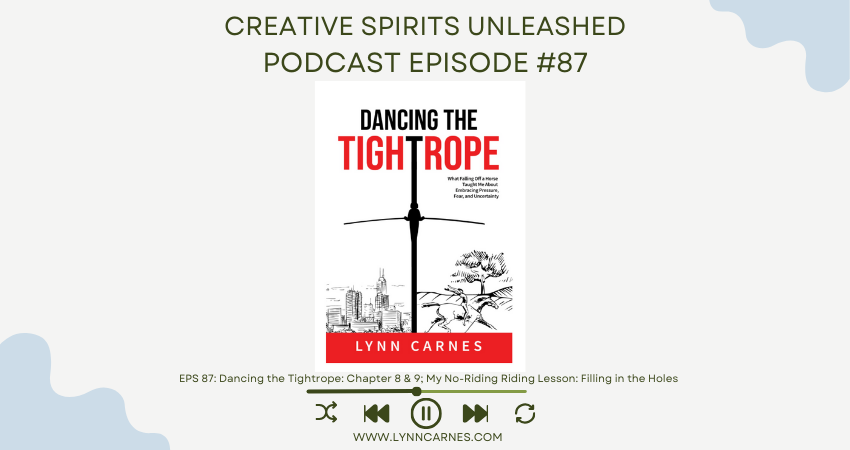In this episode of the podcast, I am reading chapters 8 and 9 of Dancing the Tightrope. I'm starting to put things together, as you will hear when you listen. At the very beginning of chapter eight, I had a wild experience going out and learning the negative-positive poll in a completely new or deeper way.
Let me tell you something that's interesting about that particular super tool as I call it. It is eight years later, and I am still BEGINNING to understand just how powerful this mechanism inside of us is if we learn to use it. If there's nothing else I have for you for this podcast, pay attention to that story and see how you can start using it for yourself, because this one is powerful.
I'm also beginning to find out all the holes in my training and all the things I thought I knew that I didn't really know. Because if there's any distinction, especially around this time of the book, but maybe for the whole book, there is a big difference between knowing something and having the wisdom to know how to use it in the right place and in the right time.
I hope you enjoy these chapters of Dancing the Tightrope.
Topics
My No Riding Lessons
- Lynn recounts a phone call from Bruce, asking if she trusts herself, leading to a new location for a horse training session.
- Bruce and another professional horse trainer are working on trailering a large horse, emphasizing the dangers and necessity of the task.
- Lynn observes a session with a rescued thoroughbred, noting the trainer's past traumatic experience and the horse's stallion tendencies.
- Bruce gives Lynn the horse's halter rope, emphasizing the horse's responsibility and encouraging her to trust him.
Learning to Trust and Balance the Negative Pole
- Lynn describes her initial fear of letting go of the rope, fearing the horse might run away.
- Bruce encourages Lynn to drop the rope and trust herself, leading to a feeling of inner tension and anxiety.
- Lynn recalls a past experience with her daughter, Jen, where she felt an inner ticking sensation, which she initially misinterpreted as a sign of being a bad mother.
- Bruce helps Lynn rewrite her story about the feeling, teaching her to see it as a signal rather than a threat.
Balancing the Negative and Positive Poles
- Lynn continues to work with Bruce, learning to balance her negative and positive poles by responding to the horse's signals.
- Bruce emphasizes the importance of not overreacting or underreacting, but responding deeply to the situation.
- Lynn reflects on her past corporate persona, where she followed rules rigidly and expected others to do the same.
- She describes a transition in her leadership style, moving from command and control to facilitative teaching, which improved the learning experience for trainees.
Developing Trust and Connection with Horses
- Lynn meets Lynn Brown, who practices natural horsemanship and runs guided trail rides, and is introduced to Phoenix, a horse that becomes a significant teacher.
- Lynn Brown explains the concept of "Swiss cheese" knowledge in horsemanship, where gaps in knowledge can lead to disasters.
- Lynn reflects on her past horseback riding experience, where she made mistakes due to lack of understanding and proper training.
- Lynn begins to develop trust and connection with Phoenix through groundwork, learning to read the horse's subtle cues and body language.
The Importance of Patience and Timing
- Lynn learns about the four basic needs of horses: safety, comfort, food, and play, and how they communicate through energy and gesture.
- She observes the pecking order and dynamics of a herd of horses, learning to read their body language and signals.
- Lynn applies these lessons to her human relationships, drawing parallels between horse behavior and human interactions.
- She begins to saddle Phoenix, learning the importance of being gentle and connected, and the impact of her own body language on the horse's sense of safety.
Overcoming the Mistake Cycle
- Lynn struggles with tightening the cinch on Phoenix's saddle, showing signs of her mistake cycle, where she overreacts to mistakes.
- Bruce and Lynn Brown emphasize the importance of not beating the horse or herself, and of using mistakes as opportunities for learning.
- Lynn reflects on her past experiences with her father and other authority figures, where she internalized a rant of frustration and perfectionism.
- She begins to see the incongruity between her words, beliefs, and actions, and the impact of her conditioning on her behavior.
The Froth: The Learning Zone
- Lynn describes the "froth," a state of mind and body sensation where the old and new ways of doing things mix together.
- She experiences a moment of flow with Phoenix, where she feels relaxed and in harmony with the horse.
- Lynn reflects on how this experience changes her approach to life, bringing a sense of ease and relaxation into her daily routines.
- She continues to practice being present and responsive, using her tools to handle pressure and uncertainty.
Bringing the Flow into Everyday Life
- Lynn becomes aware of her feet and the sensation of bracing for danger, and the impact on her movements and overall well-being.
- She practices letting go and relaxing her feet, bringing the flowy feeling into her everyday life.
- Lynn reflects on the importance of facing pressure and uncertainty as an opportunity to use her tools and respond deeply.
- She concludes the podcast by inviting feedback from listeners and encouraging them to share the podcast with others.

